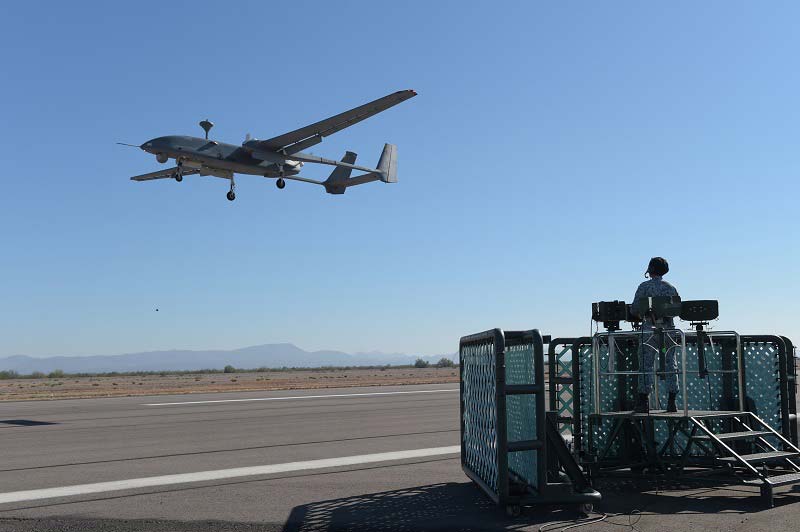For the first time, the Singapore Armed Forces (SAF) successfully destroyed multiple mobile targets in a single pass in both day and night missions.
This involved five different Republic of Singapore Air Force (RSAF) assets - the F15SGs, the F-16C/Ds, the AH-64D Apache helicopters and the Heron-1 Unmanned Aerial Vehicles (UAVs) - working closely together through cooperative lasing to take out the targets spotted.
The Heron-1 UAV is first launched to survey the area. Once it spots the six mobile enemy targets, the information is relayed to the command post. After analysing the information, the command post gives orders to the rest of the fighter aircraft and attack helicopters, which are already in the air, to take out the targets.
Guided by the UAV's laser system, the aircraft are able to deliver a precise strike, hitting the mobile targets within a single pass.
This scenario was played out during Exercise Forging Sabre 2015 and part of it was witnessed by Minister for Defence Dr Ng Eng Hen on 12 Dec. Held from 1 to 16 Dec in Phoenix, Arizona, this large-scale biennial exercise involved about 600 airmen and soldiers.
This integrated strike mission tested the SAF's sensor-shooter capabilities with the maiden participation of the Heron-1 UAV. Besides providing enhanced Air Intelligence, Surveillance and Reconnaissance capabilities, the UAV has the ability to conduct lasing with the fighter aircraft and attack helicopters to mark targets.
The exercise's Air Director, Senior Lieutenant-Colonel (SLTC) Liew Boon Ping, explained that in the past, one fighter aircraft could only laser-guide one bomb at a time. But with the help of lasing from the Heron-1 UAV, the number of guided bombs has increased.
"When I send four F-15SGs, they can guide only four bombs. But now, we have stretched (their capabilities) with the Heron-1, (and) can guide up to six bombs effectively," he said.
For cooperative lasing to take place, the aircraft use advanced munitions, such as the Joint Direct Attack Munitions (JDAMs), Laser JDAMs, Hellfire missiles, and GBU-10 and GBU-12 Laser Guided Bombs, to destroy static and mobile targets in day and night mission scenarios.
Overall Exercise Director and Commander Air Combat Command Colonel (COL) Tommy Tan said that this year's exercise, the most realistic and complex to date, was a test of both their air-to-air and air-to-ground capabilities with a very realistic and reactive enemy force and the presence of multiple mobile targets.
They had also increased the complexity of the mission by having shelters built for the targets to hide in. As these shelters blend into the desert grounds, this made spotting, analysing and destroying targets more difficult.
"When the target is on the move, it's more difficult to update the picture on the ground. After we pump the intelligence to the command post, they will decide on the most effective air or ground platforms to take out the targets. This not just tests the competency of the operators, (but also) validates the weapons' capabilities."
As part of his visit, Dr Ng observed a live firing from the backseat of an F-15SG. He saw how the F-15SGs dropped their bombs on enemy targets in an integrated strike mission together with the Heron- 1 UAVs.
He also interacted with exercise participants and servicemen from the RSAF's Peace Carvin II F-16C/D detachment in US, and viewed a static display of the F-35 Joint Strike Fighter.
Post-flight, Dr Ng commented that the seats in the cockpit of the F-15SG was like "flying first class compared to economy". He was referring to his flight on the F-16C/D some years ago.
"The avionics has improved tremendously and the capabilities give us a lot of confidence. Our pilots are very well-trained, completely professional and what I liked about the systems is that it's very methodical."
He added that the targeting and smart munitions performance, as well as the night mission he viewed on 11 Dec, were a "real confidence booster to the SAF and its integrated systems". Regular training and being able to train in the vast US airspace were also reasons why the SAF had been able to tremendously improve its capabilities over the last 10 years.
"I think very few militaries around the world train (in) as high tempo and with such complex scenarios as we do."
Commenting on the SAF's professionalism, he said: "What we do at this level is not easy (but) we just have to keep doing it. The reason we do it is that the stronger we are, the easier it is to keep our peace."
During his visit, Dr Ng was accompanied by Chief of Air Force Major-General Hoo Cher Mou, as well as other senior SAF and US Air Force officers.
